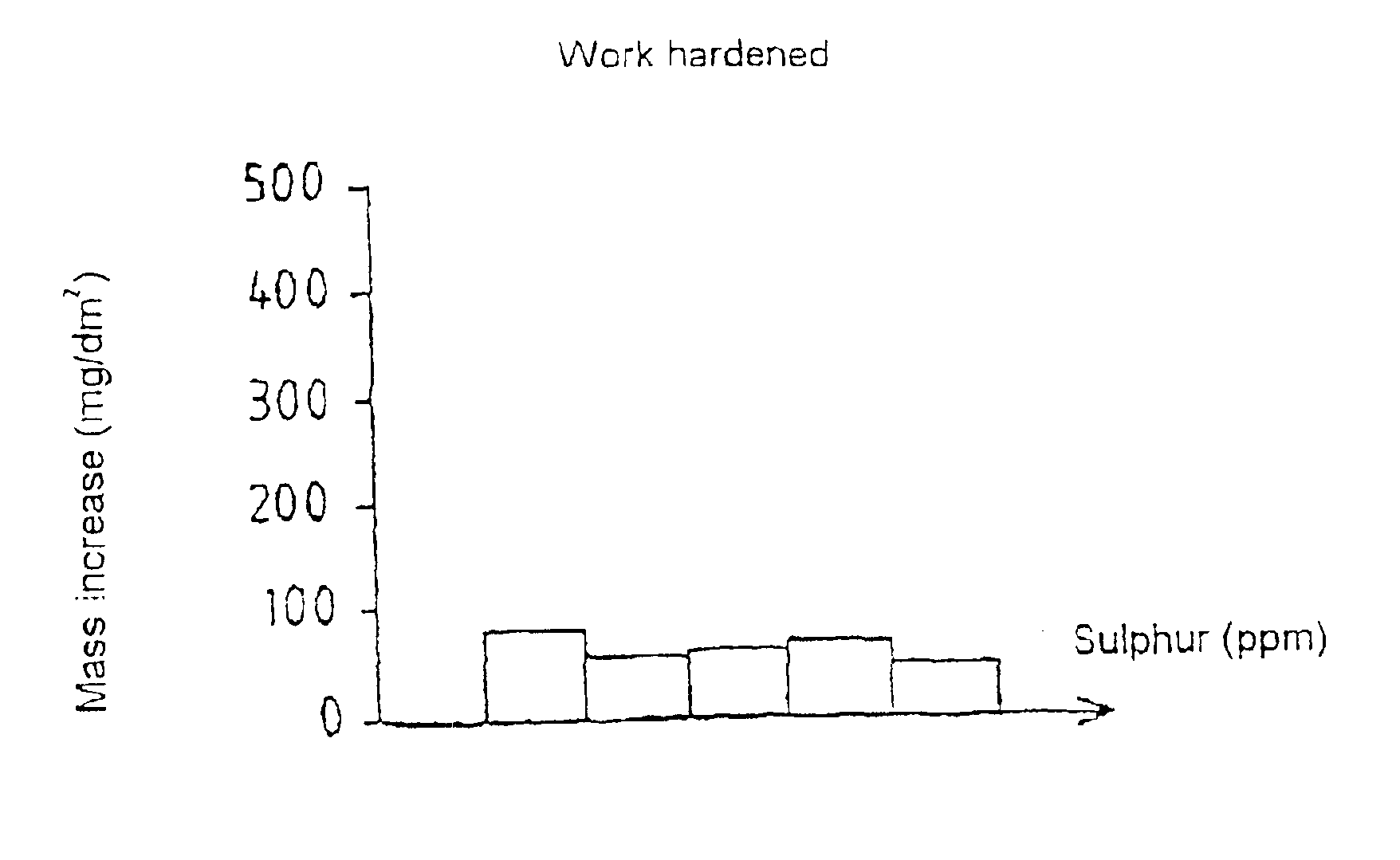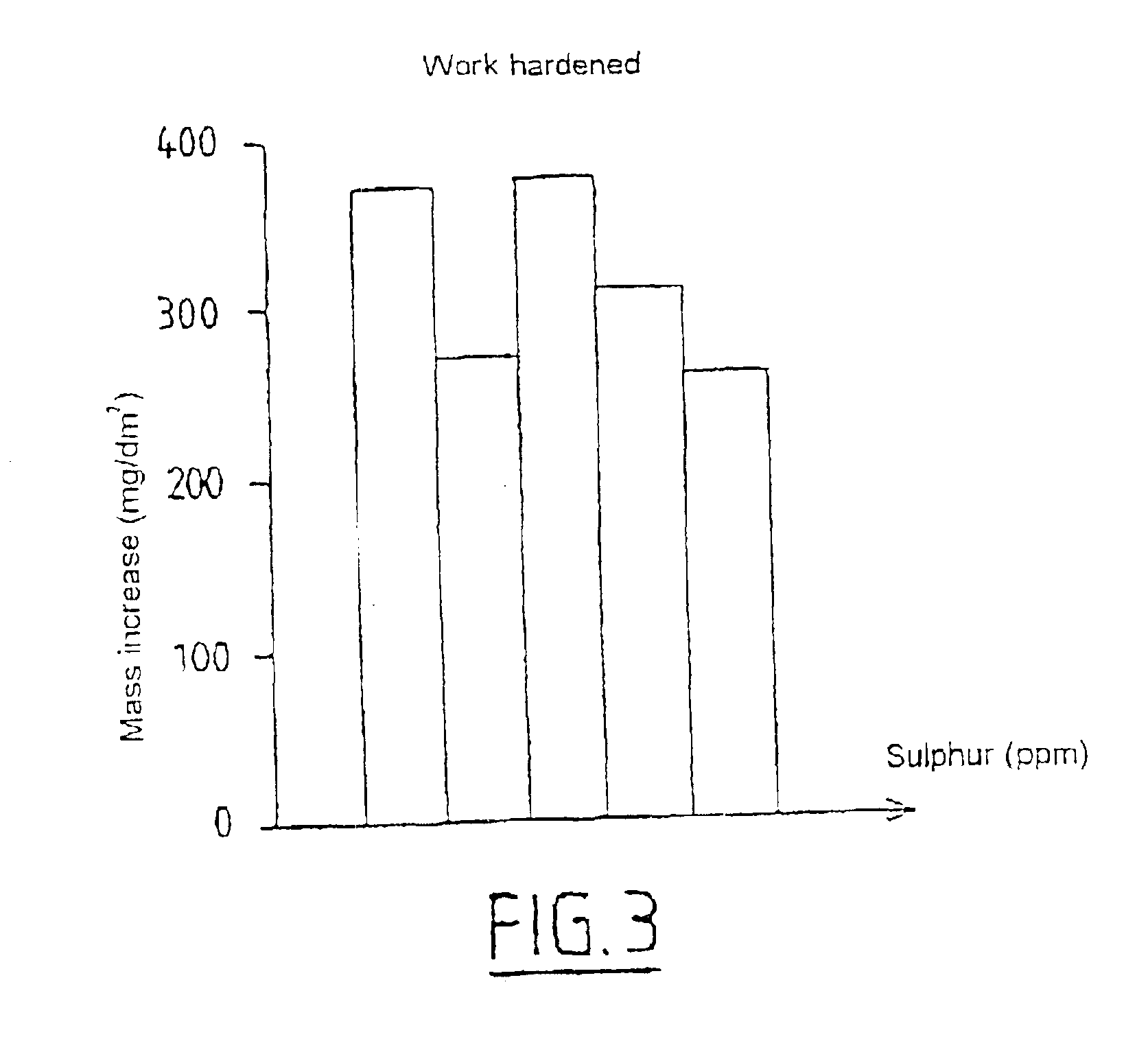Zirconium alloy highly resistant to corrosion and to sun burst by water and water vapor and method for thermomechanical transformation of the alloy
a zirconium alloy, high corrosion resistance technology, applied in the direction of distance measurement, greenhouse gas reduction, instruments, etc., can solve the problem that the heat treatment cycle does not make it possible in general to optimize sulphur, and achieve satisfactory rollability properties and increase corrosion and hydriding resistance of zirconium alloys.
- Summary
- Abstract
- Description
- Claims
- Application Information
AI Technical Summary
Benefits of technology
Problems solved by technology
Method used
Image
Examples
example 1
[0033]Specimens of unalloyed zirconium containing variable amounts of sulphur, within a range from 6 to 1000 ppm, were produced. The sulphur was added in the form of zirconium sulphide. Corrosion tests were carried out in 400° C. steam at 105 bar for periods of 1 day, 8 days, 28 days and 54 days.
[0034]In Table 1 given below, the first column gives the sulphur content (in ppm) of the zirconium specimens used for the tests.
[0035]
TABLE 1400° C. STEAMat 105 barS ppm1 day8 days28 days54 days641312289Unalloyed16338zirconium2630363120719292651651522302181321283611321288492428Zy414223134
[0036]Given in the next four columns are the increases in mass of the specimens, in mg / dm2, after keeping the specimen in 400° C. steam for the time (in days) indicated at the top of the column.
[0037]The last row of Table 1 relates to a comparative specimen made of Zircaloy 4, that is to say a zirconium alloy which contains mainly tin, iron and chromium and the sulphur content of which is less than 5 ppm.
[00...
example 2
[0042]In the case of zirconium alloys conventionally used for producing elements in contact with water or steam at high temperature such as Zircaloy 4 or Zircaloy 2, which are alloys containing particularly iron and chromium, it is known that the precipitation of intermetallic compounds such as Zr(CrFe)2 has a beneficial effect on the corrosion resistance.
[0043]However, in the case of the intermetallic compounds in the known alloys, which may contain for example iron, chromium, nickel, niobium, vanadium or oxygen, it is known that the intermetallic compounds do have a favourable effect but this varies depending on the size of the precipitates formed in the alloy.
[0044]In the case where it is desired to have resistance to uniform corrosion and to corrosion in water at high pressure and high temperature (PWR environment), alloys are sought which contain precipitates of intermetallic compounds which are preferably large in size.
[0045]In contrast, in the case where it is desired to have...
PUM
| Property | Measurement | Unit |
|---|---|---|
| size | aaaaa | aaaaa |
| size | aaaaa | aaaaa |
| temperature | aaaaa | aaaaa |
Abstract
Description
Claims
Application Information
 Login to View More
Login to View More - R&D
- Intellectual Property
- Life Sciences
- Materials
- Tech Scout
- Unparalleled Data Quality
- Higher Quality Content
- 60% Fewer Hallucinations
Browse by: Latest US Patents, China's latest patents, Technical Efficacy Thesaurus, Application Domain, Technology Topic, Popular Technical Reports.
© 2025 PatSnap. All rights reserved.Legal|Privacy policy|Modern Slavery Act Transparency Statement|Sitemap|About US| Contact US: help@patsnap.com



